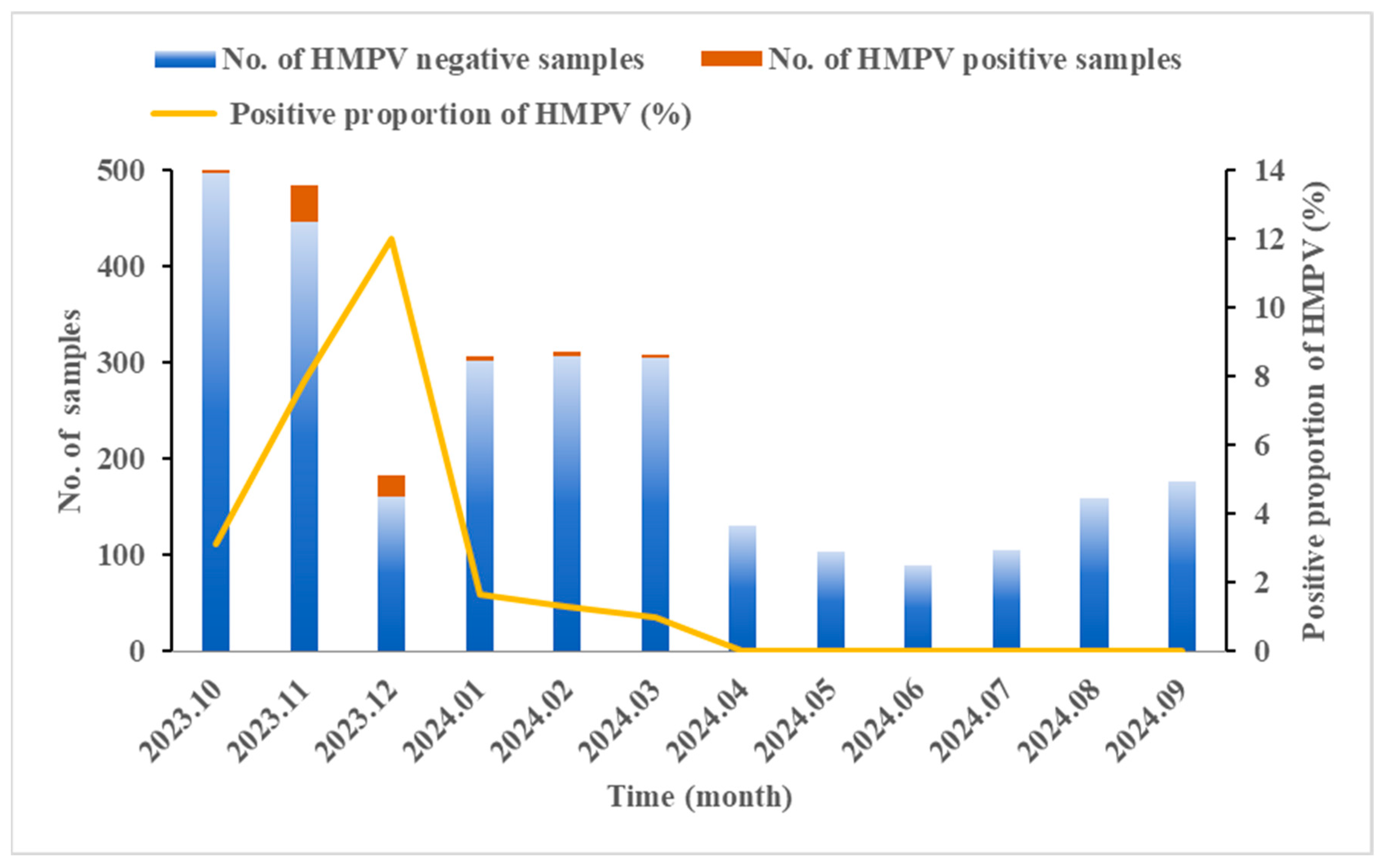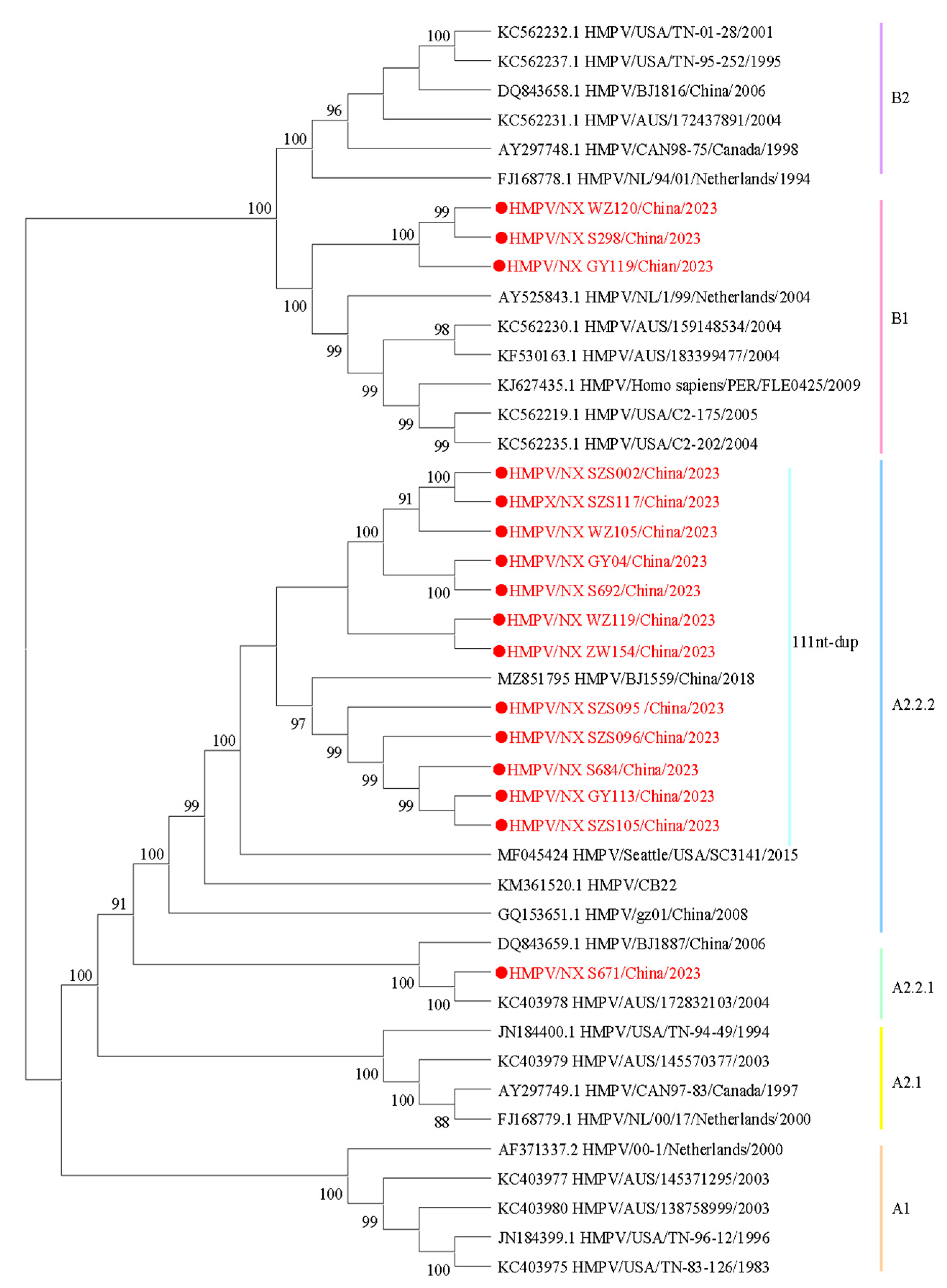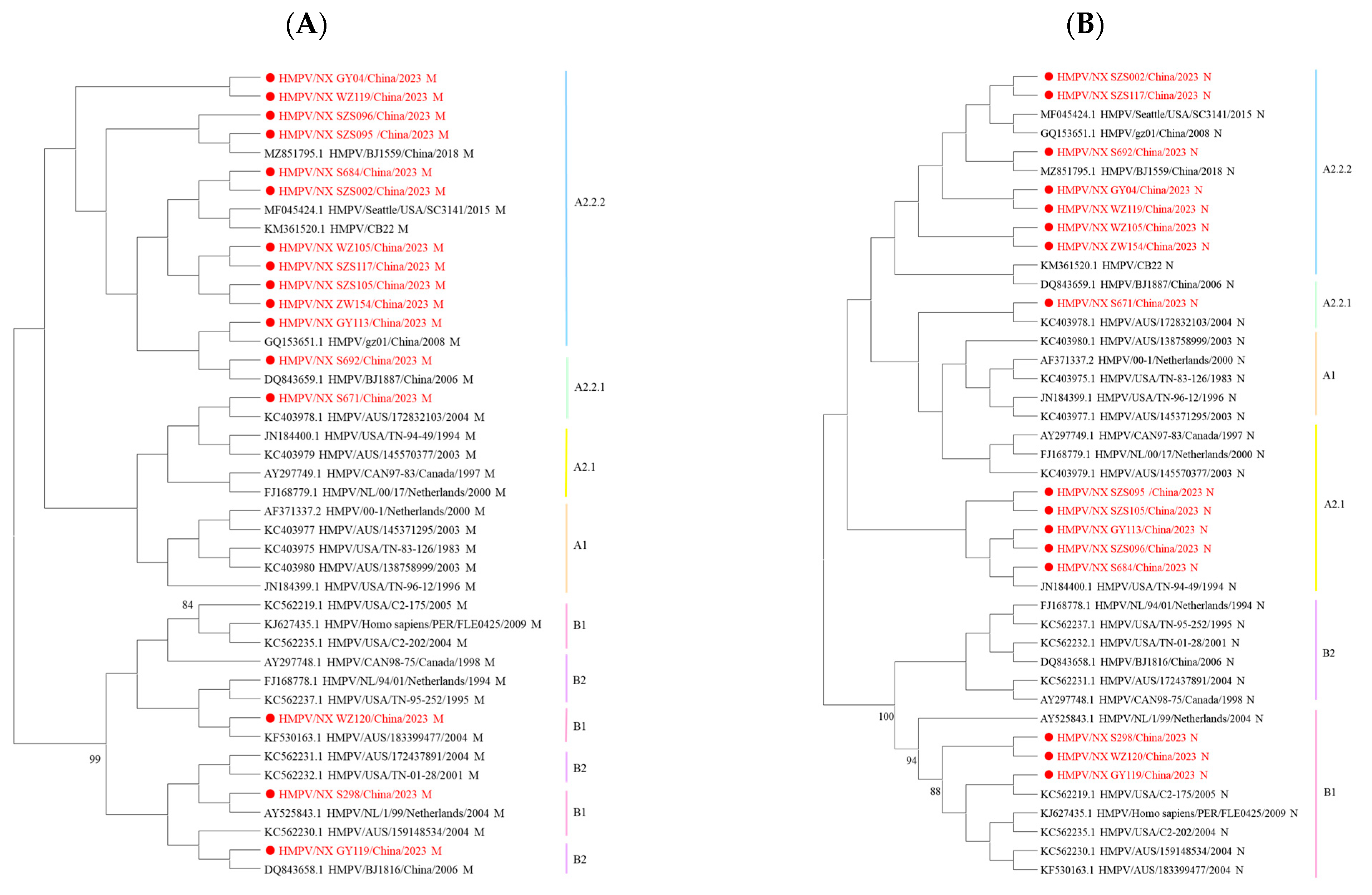Epidemiology and Genetic Diversity of Human Metapneumovirus in Patients with Severe Acute Respiratory Infection from 2023 to 2024 in Ningxia, China
Abstract
1. Introduction
2. Methods
2.1. Case Sources and Sample Collection
2.2. Detection of Human Metapneumovirus
2.3. Epidemiological Method
2.4. Whole-Genome Sequencing
2.5. Bio-Informatics Analysis
2.6. Statistical Analysis
3. Results
3.1. Epidemiology of HMPV Infection
3.2. Coinfection with Other Respiratory Viruses
3.3. Phylogenetic Analysis of HMPV Whole Genome
4. Sequence Analysis of HMPV Genes
5. Conserved and Divergent Features of HMPV G Protein
6. Discussion
7. Conclusions
Author Contributions
Funding
Institutional Review Board Statement
Informed Consent Statement
Data Availability Statement
Acknowledgments
Conflicts of Interest
References
- Panda, S.; Mohakud, N.K.; Pena, L.; Kumar, S. Human metapneumovirus: Review of an important respiratory pathogen. Int. J. Infect. Dis. 2014, 25, 45–52. [Google Scholar] [CrossRef]
- Hoogen, B.G.V.D.; Jong, J.C.D.; Groen, J.; Kuiken, T.; Groot, R.D.; Fouchier, R.A.M.; Osterhaus, A.D.M.E. A newly discovered human pneumovirus isolated from young children with respiratory tract disease. Nat. Med. 2001, 7, 719–724. [Google Scholar] [CrossRef] [PubMed]
- Wang, X.; Li, Y.; Deloria-Knoll, M.; Madhi, S.A.; Morpeth, S. Global burden of acute lower respiratory infection associated with human metapneumovirus in children under 5 years in 2018: A systematic review and modelling study. Lancet Glob. Health 2020, 9, e33–e43. [Google Scholar] [CrossRef] [PubMed]
- Sah, R.; Srivastava, S.; Kumar, S.; Rao, G.S.K.; Mehta, R.; Mohanty, A.; Sah, S.; Mehta, V.; Feehan, J.; Apostolopoulos, V.; et al. Ongoing hMPV outbreaks in China and other Asian countries. Infez. Med. 2025, 33, 1–3. [Google Scholar] [CrossRef] [PubMed]
- Falsey, A.R.; Walsh, E.E.; House, S.; Vandenijck, Y.; Ren, X.; Keim, S.; Kang, D.; Peeters, P.; Witek, J.; Ispas, G. Risk Factors and Medical Resource Utilization of Respiratory Syncytial Virus, Human Metapneumovirus, and Influenza-Related Hospitalizations in Adults-A Global Study During the 2017-2019 Epidemic Seasons (Hospitalized Acute Respiratory Tract Infection [HARTI] Study). Open Forum. Infect. Dis. 2021, 8, ofab491. [Google Scholar] [CrossRef]
- Howard, L.M.; Edwards, K.M.; Yuwei, Z.; Griffin, M.R.; Weinberg, G.A.; Szilagyi, P.G.; Staat, M.A.; Payne, D.C.; Williams, J.V. Clinical Features of Human Metapneumovirus Infection in Ambulatory Children Aged 5–13 Years. J. Pediatr. Infect. Dis. Soc. 2017, 7, 165–168. [Google Scholar] [CrossRef]
- Guo, L.; Li, L.; Liu, L.; Zhang, T.; Sun, M. Neutralising antibodies against human metapneumovirus. Lancet Microbe 2023, 4, e732–e744. [Google Scholar] [CrossRef]
- Mishra, B.; Mohapatra, D.; Tripathy, M.; Mamidi, P.; Mohapatra, P.R. A Re-emerging Respiratory Virus: Human Metapneumovirus (hMPV). Cureus 2025, 17, e78354. [Google Scholar] [CrossRef]
- van den Hoogen, B.G.; Bestebroer, T.M.; Osterhaus, A.D.; Fouchier, R.A. Analysis of the Genomic Sequence of a Human Metapneumovirus. Virology 2002, 295, 119–132. [Google Scholar] [CrossRef]
- Biacchesi, S.; Skiadopoulos, M.H.; Boivin, G.; Hanson, C.T.; Murphy, B.R.; Collins, P.L.; Buchholz, U.J. Genetic diversity between human metapneumovirus subgroups. Virology 2003, 315, 1–9. [Google Scholar] [CrossRef]
- Kim, J.I.; Park, S.; Lee, I.; Park, K.S.; Kwak, E.J.; Moon, K.M.; Lee, C.K.; Bae, J.-Y.; Park, M.-S.; Song, K.-J. Genome-Wide Analysis of Human Metapneumovirus Evolution. PLoS ONE 2016, 11, e0152962. [Google Scholar] [CrossRef] [PubMed]
- Xie, Z.; Zhu, Z.; Xu, J.; Mao, N.; Cui, A.; Wang, W.; Wang, Y.; Zhang, Z.; Xia, B.; Wang, H.; et al. Seasonal and Genetic Characteristics of Human MetapneumovirusCirculating—Henan Province, China, 2017–2023. China CDC Wkly. 2024, 6, 450–456. [Google Scholar] [CrossRef] [PubMed]
- Miwako, S.; Chiharu, K.; Naganori, N.; Makoto, T.; Shuzo, U.; Tadayoshi, S.; Kimiko, N.; Takahiro, T. 180-Nucleotide Duplication in the G Gene of Human metapneumovirus A2b Subgroup Strains Circulating in Yokohama City, Japan, since 2014. Front. Microbiol. 2017, 8, 402. [Google Scholar] [CrossRef]
- Saikusa, M.; Nao, N.; Kawakami, C.; Usuku, S.; Sasao, T.; Toyozawa, T.; Takeda, M.; Okubo, I. A novel 111-nucleotide duplication in the G gene of human metapneumovirus. Microbiol. Immunol. 2017, 61, 507–512. [Google Scholar] [CrossRef] [PubMed]
- Shirato, K.; Suwa, R.; Nao, N.; Kawase, M.; Sugimoto, S.; Kume, Y.; Chishiki, M.; Ono, T.; Okabe, H.; Norito, S.; et al. Molecular Epidemiology of Human Metapneumovirus in East Japanbefore and after COVID-19, 2017–2022. Jpn. J. Infect. Dis. 2024, 77, 137–143. [Google Scholar] [CrossRef]
- Piñana, M.; González-Sánchez, A.; Andrés, C.; Abanto, M.; Vila, J.; Esperalba, J.; Moral, N.; Espartosa, E.; Saubi, N.; Creus, A.; et al. The emergence, impact, and evolution of human metapneumovirus variants from 2014 to 2021 in Spain. J. Infect. 2023, 87, 103–110. [Google Scholar] [CrossRef]
- Groen, K.; van Nieuwkoop, S.; Meijer, A.; van der Veer, B.; van Kampen, J.J.A.; Fraaij, P.L.; Fouchier, R.A.M.; van den Hoogen, B.G. Emergence and Potential Extinction of Genetic Lineages of Human Metapneumovirus between 2005 and 2021. mBio 2023, 14, e02280-22. [Google Scholar] [CrossRef]
- Muñoz-Escalante, J.C.; Mata-Moreno, G.; Rivera-Alfaro, G.; Noyola, D.E. Global Extension and Predominance of Human Metapneumovirus A2 Genotype with Partial G Gene Duplication. Viruses 2022, 14, 1058. [Google Scholar] [CrossRef]
- Xie, Z.; Xu, J.; Ren, Y.; Cui, A.; Wang, H.; Song, J.; Zhang, Q.; Hu, M.; Xu, W.; Zhang, Y. Emerging Human Metapneumovirus Gene Duplication Variants in Patients with Severe Acute Respiratory Infection, China, 2017–2019. Emerg. Infect. Dis. 2021, 27, 275–277. [Google Scholar] [CrossRef]
- Min, X.; Wang, Y.; Dong, X.; Dong, X.; Wang, N.; Wang, Z.; Shi, L. Epidemiological characteristics of human metapneumovirus among children in Nanjing, China. Eur. J. Clin. Microbiol. Infect. Dis. 2024, 43, 1445–1452. [Google Scholar] [CrossRef]
- Zhang, J.; Bai, X.; Jin, Y.; Ye, Q.; Lei, X.; Li, L. Study on human metapneumovirus in children infection status in Yinchuan. Ningxia Med. J. 2013, 35, 612–613. [Google Scholar] [CrossRef]
- Jinhan, S.; Binghan, C.; Kai, J.; Liang, Z.; Lei, H.; Fang, L. Analysis of clinical characteristics of Human Metapneumovirus Infection Patients in 878 Cases of Hospitalized Children with Community-Acquired Pneumonia in Yinchuan City. J. Fujian Med. Univ. 2024, 58, 182–187. [Google Scholar] [CrossRef]
- Wang, X.; Su, Y.; Wu, Z.; Cao, M.; Li, L.; Pei, J.; Ma, X. Whole genome characteristics of respiratory human metapneumovirus isolated in Ningxia Hui Autonomous Region. Chin. J. Public Health 2023, 39, 918–923. [Google Scholar] [CrossRef]
- Tulloch, R.L.; Kok, J.; Carter, I.; Dwyer, D.E.; Eden, J.S. An Amplicon-Based Approach for the Whole-Genome Sequencing of Human Metapneumovirus. Viruses 2021, 13, 499. [Google Scholar] [CrossRef]
- Bastien, N.; Liu, L.; Ward, D.; Taylor, T.; Li, Y. Genetic Variability of the G Glycoprotein Gene of Human Metapneumovirus. J. Clin. Microbiol. 2004, 42, 3532–3537. [Google Scholar] [CrossRef]
- Centers for Disease Control and Prevention (CDC). About Human Metapneumovirus; Centers for Disease Control and Prevention (CDC): Atlanta, GA, USA, 2023. Available online: https://www.cdc.gov/human-metapneumovirus/about/index.html (accessed on 30 June 2025).
- Haas, L.; Thijsen, S.; Van Elden, L.; Heemstra, K. Human Metapneumovirus in Adults. Viruses 2013, 5, 87–110. [Google Scholar] [CrossRef] [PubMed]
- Lefebvre, A.; Manoha, C.; Bour, J.B.; Abbas, R.; Fournel, I.; Tiv, M.; Pothier, P.; Astruc, K.; Aho-Glélé, L.S. Human metapneumovirus in patients hospitalized with acute respiratory infections: A meta-analysis. J. Clin. Virol. 2016, 81, 68–77. [Google Scholar] [CrossRef] [PubMed]
- Zhao, H.; Feng, Q.; Feng, Z.; Zhu, Y.; Ai, J.; Xu, B.; Deng, L.; Sun, Y.; Li, C.; Jin, R. Clinical characteristics and molecular epidemiology of human metapneumovirus in children with acute lower respiratory tract infections in China, 2017 to 2019: A multicentre prospective observational study. Virol. Sin. 2022, 37, 874–882. [Google Scholar] [CrossRef]
- Wang, C.; Wei, T.; Ma, F.; Wang, H.; Guo, J.; Chen, A.; Huang, Y.; Xie, Z.; Zheng, L. Epidemiology and genotypic diversity of human metapneumovirus in paediatric patients with acute respiratory infection in Beijing, China. Virol. J. 2021, 18, 40. [Google Scholar] [CrossRef] [PubMed]
- Ji, L.; Chen, L.; Xu, D.; Wu, X. Molecular typing and epidemiologic profiles of human metapneumovirus infection among children with severe acute respiratory infection in Huzhou, China. Mol. Biol. Rep. 2021, 48, 7697–7702. [Google Scholar] [CrossRef]
- Taha, A.M.; Sabet, C.J.; Nguyen, D.; Rodriguez-Morales, A.J. Controlling the rising burden of the human metapneumovirus (hMPV) infections in vulnerable populations in China. J. Infect. Public Health 2025, 18, 102844. [Google Scholar] [CrossRef] [PubMed]
- Wenhua, K.; Ying, W.; Honghao, Z.; Xinming, L.; Bin, Y.; Quan, H.; Xiaobing, Y.; Deyin, G.; Jinsong, P.; Dunjin, Z. Circulation of human metapneumovirus among children with influenza-like illness in Wuhan, China. J. Med. Virol. 2016, 88, 774–781. [Google Scholar] [CrossRef]
- Ji, W.; Chen, Y.; Han, S.; Dai, B.; Li, K.; Li, S.; Li, Z.; Chen, S.; Zhang, Y.; Zhang, X.; et al. Clinical and epidemiological characteristics of 96 pediatric human metapneumovirus infections in Henan, China after COVID-19 pandemic: A retrospective analysis. Virol. J. 2024, 21, 100. [Google Scholar] [CrossRef]
- Althouse, B.M.; Flasche, S.; Toizumi, M.; Nguyen, H.-A.T.; Vo, H.M.; Le, M.N.; Hashizume, M.; Ariyoshi, K.; Anh, D.D.; Rodgers, G.L.; et al. Differences in clinical severity of respiratory viral infections in hospitalized children. Sci. Rep. 2021, 11, 5163. [Google Scholar] [CrossRef]
- Liu, W.; Zhang, H.; Zhao, T.; Cai, X.; Yang, L.; Gao, G.; Che, X.; Zhu, Z.; Zeng, T.; Cui, F. Molecular Epidemiology and Clinical Characteristics of an Outbreak on Respiratory Virus Coinfection in Gansu, China. Viruses 2024, 16, 540. [Google Scholar] [CrossRef] [PubMed]
- Thammawat, S.; Sadlon, T.A.; Hallsworth, P.G.; Gordon, D.L. Role of cellular glycosaminoglycans and charged regions of viral G protein in human metapneumovirus infection. J. Virol. 2008, 82, 11767–11774. [Google Scholar] [CrossRef] [PubMed]
- Piñana, M.; Vila, J.; Maldonado, C.; Galano-Frutos, J.J.; Valls, M.; Sancho, J.; Nuvials, F.X.; Andrés, C.; Martín-Gómez, M.T.; Esperalba, J.; et al. Insights into immune evasion of human metapneumovirus: Novel 180- and 111-nucleotide duplications within viral G gene throughout 2014–2017 seasons in Barcelona, Spain. J. Clin. Virol. 2020, 132, 104590. [Google Scholar] [CrossRef]
- Hoogen, B.G.v.d.; Herfst, S.; Sprong, L.; Cane, P.A.; Forleo-Neto, E.; Swart, R.L.d.; Osterhaus, A.D.M.E.; Fouchier, R.A.M. Antigenic and Genetic Variability of Human Metapneumoviruses. Emerg. Infect. Dis. 2004, 10, 658–666. [Google Scholar] [CrossRef]
- Shrock, E.L.; Timms, R.T.; Kula, T.; Mena, E.L.; West, A.P.; Guo, R.; Lee, I.H.; Cohen, A.A.; McKay, L.G.A.; Bi, C.; et al. Germline-encoded amino acid–binding motifs drive immunodominant public antibody responses. Science 2023, 380, eadc9498. [Google Scholar] [CrossRef]
- Hao, A.; Song, W.; Li, C.; Zhang, X.; Tu, C.; Wang, X.; Wang, P.; Wu, Y.; Ying, T.; Sun, L. Defining a highly conserved cryptic epitope for antibody recognition of SARS-CoV-2 variants. Signal Transduct. Target. Ther. 2023, 8, 269. [Google Scholar] [CrossRef]



| Variable | Number of Samples Tested | Number of HMPV-Positive Samples | Positive Proportion of HMPV (%) | χ2 | p-Value |
|---|---|---|---|---|---|
| Gender | 0.161 | 0.688 | |||
| Male | 1497 | 44 | 2.94 | ||
| Female | 1376 | 44 | 3.20 | ||
| Age (years group) | 22.298 | p < 0.001 | |||
| 0–4 | 448 | 25 | 5.58 | ||
| ~1 | 173 | 9 | 5.20 | 10.595 | 0.014 |
| ~2 | 68 | 1 | 1.47 | ||
| ~3 | 88 | 2 | 2.27 | ||
| ~4 | 119 | 13 | 10.92 | ||
| 5–14 | 610 | 28 | 4.59 | ||
| 15–44 | 298 | 5 | 1.68 | ||
| 45–64 | 459 | 9 | 1.96 | ||
| ≥65 | 1058 | 21 | 1.98 | ||
| Total | 2873 | 88 | 3.06 | ||
| Viruses Detected in Coinfection | No. (%, n = 88) | |
|---|---|---|
| Single infection | 68 (77.27) | |
| Coinfection | HMPV + SARS-CoV-2 | 3 (3.41) |
| HMPV + RSV | 3 (3.41) | |
| HMPV + HRV | 6 (6.82) | |
| HMPV + AdV | 2 (2.27) | |
| HMPV + MP | 6 (6.82) | |
| Total | 88 |
| Gene | % Nucleotide Sequence Identity Within Genotype | % Nucleotide Sequence Identity Between Genotype A and B | % Amino Acid Sequence Identity Within Genotype | % Amino Acid Sequence Identity Between Genotype A and B | ||
|---|---|---|---|---|---|---|
| A | B | A | B | |||
| N | 95.9–100 | 98.7–99.9 | 85–86.9 | 99.2–100 | 98.7–100 | 93.9–95.7 |
| P | 96–100 | 99.9–100 | 79.2–80.5 | 96.6–100 | 100 | 83.1–84.7 |
| M | 95.6–100 | 99.7–99.9 | 84.2–86.3 | 99.6–100 | 100 | 97.3–97.6 |
| F | 95.1–100 | 99.9–100 | 83.3–84 | 99.1–100 | 99.8–100 | 94.1–94.6 |
| M2 | 96.1–100 | 99.7–100 | 84.3–85.3 | 95.5–100 | 99.6–100 | 86–87.2 |
| SH | 94.2–100 | 98.7–99.6 | 68.8–71.5 | 92.4–100 | 98.4–100 | 57.8–61.6 |
| G | 73.9–100 | 99.5–99.6 | 52.7–55.4 | 64.7–100 | 99.3–99.8 | 30.5–37.8 |
| L | 95.8–100 | 98.3–99.9 | 83.9–85.7 | 98.8–100 | 99.3–99.8 | 93.8–94.7 |
| Genotype | Name | Length | N-Linked Glycosylation- | O-Linked Glycosylation (Number) | ||
|---|---|---|---|---|---|---|
| Number | Positive Residues | Serine | Threonine | |||
| A2.2.1 | HMPV/NX S671/China/2023 | 228 | 5 | 30/52/140/145/155 | 34 | 42 |
| A2.2.2 | HMPV/NX SZS095/China/2023 | 220 | 3 | 30/52/145 | 34 | 33 |
| 111nt-dup | HMPV/NX GY04/China/2023 | 264 | 3 | 30/52/256 | 40 | 44 |
| HMPV/NX GY113/China/2023 | 264 | 5 | 30/52/122/145/256 | 43 | 44 | |
| HMPV/NX S684/China/2023 | 264 | 5 | 30/52/122/145/256 | 43 | 43 | |
| HMPV/NX S692/China/2023 | 264 | 3 | 30/52/256 | 42 | 44 | |
| HMPV/NX SZS002/China/2023 | 264 | 3 | 30/52/256 | 40 | 45 | |
| HMPV/NX SZS096/China/2023 | 264 | 5 | 30/52/122/145/256 | 42 | 42 | |
| HMPV/NX WZ119/China/2023 | 264 | 5 | 30/52/152/218/256 | 43 | 45 | |
| HMPV/NX WZ105/China/2023 | 264 | 3 | 30/52/256 | 42 | 46 | |
| HMPV/NX SZS105/China/2023 | 264 | 5 | 30/52/122/145/256 | 43 | 44 | |
| HMPV/NX ZW154/China/2023 | 265 | 4 | 30/52/138/256 | 39 | 46 | |
| HMPV/NX SZS117/China/2023 | 264 | 3 | 30/52/256 | 40 | 45 | |
| B1 | HMPV/NX GY119/China/2023 | 241 | 5 | 118/167/181/184/188 | 17 | 51 |
| HMPV/NX S298/China/2023 | 241 | 5 | 118/167/181/184/188 | 17 | 50 | |
| HMPV/NX WZ120/China/2023 | 241 | 5 | 118/167/181/184/188 | 17 | 50 | |
Disclaimer/Publisher’s Note: The statements, opinions and data contained in all publications are solely those of the individual author(s) and contributor(s) and not of MDPI and/or the editor(s). MDPI and/or the editor(s) disclaim responsibility for any injury to people or property resulting from any ideas, methods, instructions or products referred to in the content. |
© 2025 by the authors. Licensee MDPI, Basel, Switzerland. This article is an open access article distributed under the terms and conditions of the Creative Commons Attribution (CC BY) license (https://creativecommons.org/licenses/by/4.0/).
Share and Cite
Mu, T.; Pei, J.; Wang, J.; Niu, L.; Wu, Z. Epidemiology and Genetic Diversity of Human Metapneumovirus in Patients with Severe Acute Respiratory Infection from 2023 to 2024 in Ningxia, China. Diseases 2025, 13, 255. https://doi.org/10.3390/diseases13080255
Mu T, Pei J, Wang J, Niu L, Wu Z. Epidemiology and Genetic Diversity of Human Metapneumovirus in Patients with Severe Acute Respiratory Infection from 2023 to 2024 in Ningxia, China. Diseases. 2025; 13(8):255. https://doi.org/10.3390/diseases13080255
Chicago/Turabian StyleMu, Ting, Jianxin Pei, Jingting Wang, Ling Niu, and Zhonglan Wu. 2025. "Epidemiology and Genetic Diversity of Human Metapneumovirus in Patients with Severe Acute Respiratory Infection from 2023 to 2024 in Ningxia, China" Diseases 13, no. 8: 255. https://doi.org/10.3390/diseases13080255
APA StyleMu, T., Pei, J., Wang, J., Niu, L., & Wu, Z. (2025). Epidemiology and Genetic Diversity of Human Metapneumovirus in Patients with Severe Acute Respiratory Infection from 2023 to 2024 in Ningxia, China. Diseases, 13(8), 255. https://doi.org/10.3390/diseases13080255






